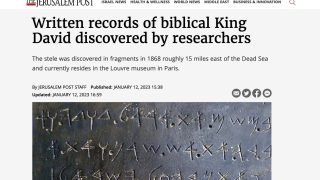
(Worthy News) – The Mesha Stele, also called the Moabite Stone, is a basalt stone slab that has provided historians and linguists with the largest source of the Moabite language to date. Researchers have only now been able to verify with a considerable degree of certainty that the stele contains explicit references to King David.
The stele was discovered in fragments in 1868 roughly 15 miles east of the Dead Sea and currently resides in the Louvre museum in Paris. While it was damaged in 1869, a paper-mache impression of the inscription was captured before the damage occurred.
The slab is etched with a lengthy account of King Mesha of Moab going to war with Israel. The events described correspond, albeit imprecisely, with a similar account in 2 Kings chapter 3. [ Source: Jerusalem Post (Read More…) ]
We're being CENSORED ... HELP get the WORD OUT! SHARE!!!
Fair Use Notice:This site contains copyrighted material the use of which has not always been specifically authorized by the copyright owner. We are making such material available in our efforts to advance understanding of environmental, political, human rights, economic, democracy, scientific, and social justice issues, etc. We believe this constitutes a 'fair use' of any such copyrighted material as provided for in section 107 of the US Copyright Law. In accordance with Title 17 U.S.C. Section 107, the material on this site is distributed without profit to those who have expressed a prior interest in receiving the included information for research and educational purposes. For more information go to: http://www.law.cornell.edu/uscode/17/107.shtml. If you wish to use copyrighted material from this site for purposes of your own that go beyond 'fair use', you must obtain permission from the copyright owner.

